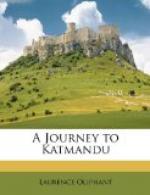Nor will the idea of a direct communication between Nepaul and Pekin seem either so improbable or impossible when we consider that an embassy now makes the journey once every five years. It occupies no less than two years, including a residence of less than two months in the capital of the Celestial Empire. I met two or three Nepaulese who had accomplished the enterprise, and who spoke in glowing terms of Pekin, and of the magnificence displayed throughout those portions of the Chinese Empire which they traversed, as well as of the great city of Lassa, and the terrible mountains to be crossed and the incredible dangers to be overcome.
The mission is composed of twenty-seven persons, and would not be admitted across the frontier of China if it consisted of one more or less than the stated number. It must arrive on the frontier on a certain day, and is subject to various rules and regulations: at the same time every provision is made by the Chinese for the comfort of the members of the embassy while on their journey. The journey from Pekin to Lassa has lately been made by Messrs. Huc and Gabet, two French missionaries, and has been graphically described by them.
The Nepaulese look with the greatest awe upon their wealthy and highly-civilized neighbours; but the Minister, having now lived amongst people more warlike and accomplished than even the Chinese, regards them with great contempt; and I should not be surprised if, before long, accounts reach us of the invasion, by the Nepaulese, of the northern provinces of China, when the Minister would bring to bear his recently acquired knowledge, and would doubtless prove more than a match for the rudely-equipped forces of his Celestial Majesty.
The Tartar race, however, who would oppose the progress of a Nepaul army, are a very different set from their tea-drinking countrymen on the southern coast.
But to return from Chinese Tartars to the country we had just quitted. The kingdom of Nepaul extends for upwards of three hundred miles along the southern slopes of the Himalayas, and is said to contain a population of about five millions. Of these four hundred thousand inhabit the valley of Nepaul proper. The lands are divided into four classes of tenures—first, crown lands; secondly, Kroos or Soona Birtha, belonging to Brahmins or Newars; thirdly, Kohriya or Bari, barren lands granted for cultivation; and, lastly (and this is the most extensive class of the four), Kaith, in which the proprietor is at all charges of tillage, dividing the produce with the cultivator.
The silver coinage of Nepaul is somewhat similar to that in use throughout British India; in all the northern provinces of which, adjoining Nepaul, it passes current: the copper coinage is most extensive, and consists of shapeless lumps of copper, eighteen or twenty of which go to a halfpenny; they are used by the natives of India in preference to their own pice.




